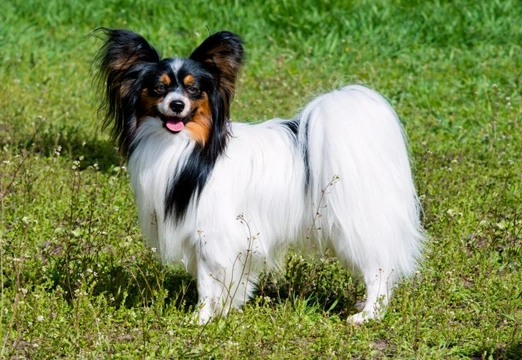
Lameness in the Papillon
Papillons are energetic little dogs that are famed for their fun-loving natures. Their beautiful ears are their best feature and this is where they get their name- ‘papillon’ means ‘butterfly’ in French! Like any dog, a Papillon will occasionally go lame, but this article will enable you to decide if there’s a major problem or not.
What causes lameness in Papillons?
Medial Patella Luxation
This is a condition that all small dogs are prone to, and Papillons in particular. The knee joint is a complicated joint and prone to lots of issues, but for small dogs luxation (or dislocation) of the patella is a major concern.
The patella or ‘knee cap’ is a small bone that moves position depending on the position of your knee. It is part of the ligament that bends the knee and runs back and forth across a groove in the femur, the large bone under the thigh. In small breeds, and papillons in particular, several things conspire to mean the bone pops out of the groove – a painful condition. Affected dogs will often ‘bunny hop’ on three legs until the patella slips back into its normal place, at which point they will often return to normal until it happens again.
Although it doesn’t appear to be a major issue in most dogs (i.e most dogs will be normal for much of the time, only having problems when running) the damage caused by the moving patella can make them more prone to other joint problems including arthritis. Some severely affected dogs will be unable to replace their patella to normal, resulting in severe lameness that does not go away- this is more likely if the dislocation of the patella is caused by a traumatic event.
Patella luxations are graded from one to four where four is the most severe. Grades of three and four should always be surgically corrected whereas a grade two luxation may not be.
Cranial Cruciate Ligament Injury
The Cranial Cruciate Ligament (or CCL) sits inside the knee. Dogs that like to exercise and play are prone to tearing this ligament, causing pain and inflammation. This is usually extremely sudden in onset and the dog will be very lame, often refusing to put any weight through the limb at all. If the tear is severe enough, the joint is destabilised resulting in unnatural movement of the bones. This is painful and also increases the chance of arthritic changes and therefore ongoing problems. Like medial patella luxation, CCL rupture can be surgically corrected.
Soft Tissue Trauma
Like any breed of dog, Papillons are prone to injuries. Foreign objects can cause soft tissue trauma and associated lameness by piercing the skin and introducing infection. Grass seeds can get caught in the fur, eventually burrowing into the skin and causing massive inflammation. Swellings caused by bruises, nail bed infections and allergic reactions can all cause soft tissue trauma, pain and lameness.
Sprain/Strain
Papillons are active little dogs that love to run and jump. They are excellent at agility and obedience and love to be doing things. Unfortunately dogs that love to be active are more prone to sprains and strains of their joints- just as active people are more likely to get a sprain. A sprain usually occurs when excessive force is put through a ligament, often at an unusual angle- the end result being that the ligaments in the joint are stretched and torn. A strain affects the tendons and muscles rather than the ligaments. Both can cause lameness that may be severe at first, but usually responds to rest and pain relief.
Arthritis
Like any species dogs can get arthritis, and the risk of them getting it is increased if the dog is very active or has previous injuries. Arthritis is unlikely to affect one joint more any other unless there is a previous injury in this joint- patella luxation for instance- so rather than a true lameness a stiffness is instead seen. Your dog will still be painful however, so you should still seek veterinary attention.
Nerve Damage
Another reason for lameness is not the muscles, bones or joints, but instead the nerves that send the signals to the muscles to move. Nerves run from your dog’s brain down his spinal cord, where they branch and leave in the neck and lower back to reach the limbs. If these nerves are damaged the leg will not move correctly, causing symptoms such as lameness. The lameness can affect one or more limbs in varying degrees of severity from paralysis to a slight limp.
Nerves are most likely to be damaged in the spinal cord. The discs that cushion the bones of the spine to allow it to move can be shunted into the spinal cord due to a trauma or impact. They can also move over time to compress the spinal cord. This is an extremely painful condition that may need surgery.
What can I do?
If you notice lameness in your Papillon, it is always worth getting it checked out. Your vet will want to examine your dog, and may suggest X-rays, or may first judge your dog’s response to rest and medication. Very active dogs may benefit from joint supplementation to increase the health of the joint and treat any inflammation from over-exercise naturally before arthritis has a chance to develop.
Overweight dogs are more prone to all of the conditions listed above, so keeping your dog at the correct weight is essential. Fine-boned and naturally light dogs like the Papillon are extra sensitive to any excess weight and even half a kilo can make their lives very difficult. It’s best to check with your vet or nurse if you aren’t sure whether your dog is an appropriate weight.



